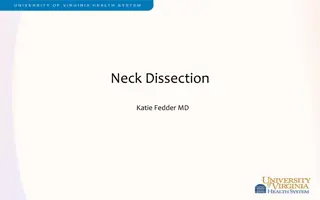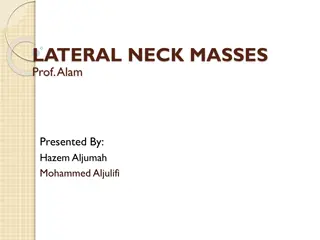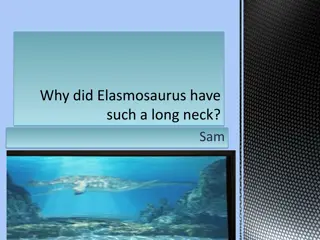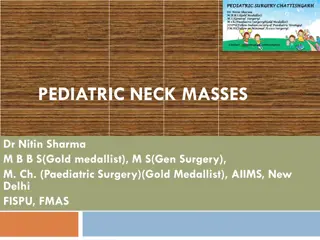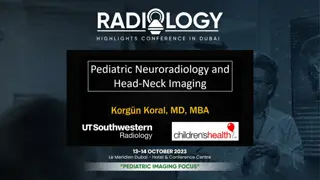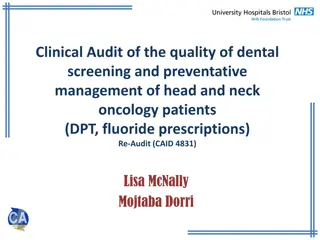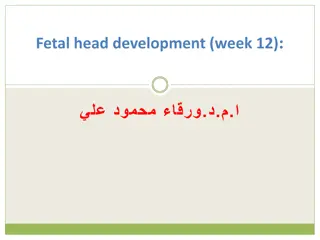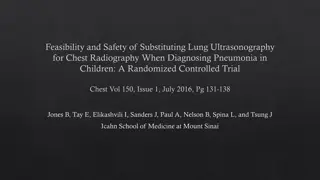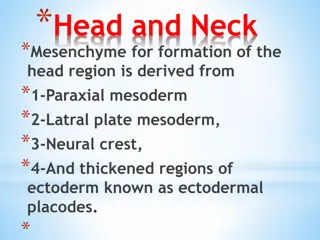Pediatric Dermatology: Recognizing and Managing Conditions in the Head and Neck
In this pediatric dermatology case study, a 4-year-old boy presents with scalp itching and hair loss. The likely cause is identified as an endothrix infection, requiring systemic treatment. Techniques to identify spores of the suspected organism are discussed, emphasizing the importance of clinical presentation for diagnosis.
Uploaded on Sep 09, 2024 | 0 Views
Download Presentation

Please find below an Image/Link to download the presentation.
The content on the website is provided AS IS for your information and personal use only. It may not be sold, licensed, or shared on other websites without obtaining consent from the author. Download presentation by click this link. If you encounter any issues during the download, it is possible that the publisher has removed the file from their server.
E N D
Presentation Transcript
Pediatric Dermatology August 2014 Pediatric Continuity Clinic Curriculum Created by: Erin Garrigan
Objectives Describe and recognize pediatric dermatological conditions that may present in the head and neck. Understand the differential diagnosis of these conditions and be able to identify the most common associated conditions or complications Be able to discuss management options and complications of treatment
Case #1 A 4 y.o previously healthy male presents to your clinic with a one week history of frequent itching in the scalp area. Mother has noticed a flaky patch and she is concerned that there is hair loss in this area. She applied oil to his hair but nothing has helped. The patch does not fluoresce under wood s lamp Healthhype.com
What is the most likely cause of his condition? T cell mediated immune response against the hair follicle Trichophyton tonsurans Microsporum canis Treponema pallidum Self inflicted
What is the most likely cause of his condition? T cell mediated immune response against the hair follicle Trichophyton tonsurans Microsporum canis Treponema pallidum Self inflicted An endothrix infection (e.g trichophyton) resides within the hair shaft, thus systemic treatment is needed to target the fungus. Black dots are present in the photo indicating broken hair flush with the scalp. Endothrix species do not fluoresce under wood s lamp. An ectothrix (e.g. microsporum) in contrast will fluouresce, and is located with spores on the outer portion of the hair shaft. T cell mediated immune response may be seen in alopecia areata and scaling would expected to be absent in this case.
To identify spores of the suspected organism, the following techniques should be used A. Examine a skin scraping of scale under the microscope with KOH B. Examine the hair shaft via KOH prep under the microscope C. Perform a punch biopsy D. Spores cannot be visualized, this is a diagnosis based on clinical presentation alone
To identify spores of the suspected organism, the following techniques should be used A. Examine a skin scraping of scale under the microscope with KOH B. Examine the hair shaft via KOH prep under the microscope C. Perform a punch biopsy D. Spores cannot be visualized, this is a diagnosis based on clinical presentation alone Spores of non fluorescent arthroconidia are located in the hair shafts. Scraping of the scale may reveal hyphae, but not spores. Punch biopsy is not indicated in this case
The patient returns to clinic several days after starting griseofulvin therapy. Mother is very concerned because the following lesions developed on his hands and she is asking for your advice. Should you A) Refer the patient to dermatology B) Reassurance C) Discontinue griseofulvin therapy D) Switch to itraconazole therapy for tinea capitis E) Obtain a punch biopsy of the lesion
The patient returns to clinic several days after starting griseofulvin therapy. Mother is very concerned because the following lesions developed on his hands and she is asking for your advice. Should you A) Refer the patient to dermatology B) Reassurance C) Discontinue griseofulvin therapy D) Switch to itraconazole therapy for tinea capitis E) Obtain a punch biopsy of the lesion This is an dermatophytid (Id) reaction which pruritic, papulovesicular eruption which represents an immune response to the fungi.
About tinea capitis May occur in several different forms, "gray patch," "black dot" and favus. Black dot tinea capitis is most associated with trychophyton species and is commonly seen in the US. Hair products, washing and use of oil not implicated in acquiring tinea capitis Spore control can be achieved with selenium sulfide 2.5% or ketoconazole 2% shampoo applies for 5-10 minutes three times per week. This therapy alone will not treat tinea capitis.
Case #2 The mother of a 4 wk old infant brings her son to your office because she is worried about a red, raised lesion that developed on his upper lip and has progressively increased in size within the last week. Breast feeding has been affected in the last few days. There were no complications with his pregnancy or delivery and mother states that this lesion was not present at his birth. Identify the lesion pictured in the next slide and discuss other possible diagnoses to consider? What is the expected natural course of this lesion, when would intervention be indicated? The patient s mother asks you what treatments are available for this lesion, what are the options and what is most appropriate for this patient?
Pediatrics In Review: Infantile Hemangiomas: An Update on Pathogenesis and Therapy Tina S. Chen, Lawrence F. Eichenfield and Sheila Fallon Friedlander Pediatrics 2013;131;99; originally published online December 24, 2012; DOI: 10.1542/peds.2012-1128
Identify the lesion pictured in the next slide and discuss other possible diagnoses to consider? This is an infantile hemangioma comprised of proliferating endothelial cells. - blanching lesion then evolves into a red macule - may become dome like, lobulated or plaque like. In contrast, noninvoluting congenital hemangiomas and rapidly involuting congenital hemangiomas RICH) are present and fully formed at birth and may be ulcerating. They may possess telangiectases and a rim of pallor and typically involute in the second year of life. Rapidly Involuting Congenital Hemangioma Birthmarks.us.case13 Dr. Konez
What is the expected natural course of this lesion, when would intervention be indicated? Most are cutaneous lesions. They typically undergo a rapid early proliferative phase, reaching their maximum size by 6 to 8 months, followed by a gradual spontaneous involution. 50% resolve completely by age 5, 70% resolve completely by age 7. Treatment may be indicated in the case of complications such as Permanent disfigurement or functional compromise Ulceration Bleeding Visual compromise Airway obstruction Congestive heart failure There may be residual scar formation, telangiectasia or loose localized skin (anetodermic) at the site of involution
The patients mother asks you what treatments are available for this lesion, what are the options and what is most appropriate for this patient? Management options include watchful waiting, steroids (topical, systemic, intralesional), surgical therapy (laser, excision) Observation Systemic therapy: hydrocortisone vs. propranolol Topical therapy: may be indicated for small, thin lesions. Pulsed dye laser: for ulcerated or thin wall lesions. May good good for cosmetic locations (fingers, eyes, lips, nasal tip, ears, face)
Hemangiomas In a newborn with multiple cutaneous hemangiomas (> 5), screen for visceral hemangiomatosis as these are the most common hepatic vascular lesions found in newborns that often are multiple and involve both lobes. PHACE Syndrome: If > 5cm hemangioma on the face, evaluate for PHACE MRI/ MRA brain, upper chest and neck, CV imaging, optho eval
Case #3 An infant presents to your clinic as a new patient. During the review of family history, you discover that there are multiple contacts in the family with tuberous sclerosis complex. Parents are concerned that the infant has TS.
The earliest cutaneous manifestation of tuberous sclerosis complex is? A. Caf au lait spots B. Ash-leaf macule C. Shagreen patch D. Facial angiofibromas E. Periungal fibroma
The earliest cutaneous manifestation of tuberous sclerosis complex is? A. Caf au lait spots B. Ash-leaf macule C. Shagreen patch D. Facial angiofibromas E. Periungal fibroma
In a patient presenting with the following skin findings, a commonly associated finding is Axillary freckling Periungual fibroma Dental pitting Comedones on the back Herald patch
In a patient presenting with the following skin findings, a commonly associated skin finding is Axillary freckling Periungual fibroma Comedones on the back Herald patch Scalp hemangiomas
Additional Information Diagnostic Criteria for TSC Major features Minor features Facial angiofibroma or forehead plaque Nontraumatic ungula or periungual fibroma Hypopigmented macules > 3 Shagreen patch (connective tissue nevus) Multiple retinal nodular hamartomas Cortical tubera Subependymal nodule SGCT Cardiac rhabdomyomas, single or multiple Lymphangioleiomyomatosis Renal angiomyolipoma Multiple randomly distributed pits in dental enamel Hamartomatous rectal polyps Bone cysts Cerebral white matter migration lines Gingival fibromas Non renal hamartomas Retinal achromic patch Confetti skin lesions Multiple renal cysts
PREP Question A mother brings her 14-year-old daughter to see you because of hair loss of several weeks duration. On physical examination, you see an area of relative alopecia located at the vertex within which are hairs of varying length There is no erythema or scaling of the scalp and no black dot hairs are apparent. During the evaluation, you note that the child seems very shy and that she bites her fingernails. Of the following, the MOST likely diagnosis is A. alopecia areata B. nevus sebaceus C. tinea capitis D. traction alopecia E. trichotillomania
PREP Question A mother brings her 14-year-old daughter to see you because of hair loss of several weeks duration. On physical examination, you see an area of relative alopecia located at the vertex within which are hairs of varying length There is no erythema or scaling of the scalp and no black dot hairs are apparent. During the evaluation, you note that the child seems very shy and that she bites her fingernails. Of the following, the MOST likely diagnosis is A. alopecia areata B. nevus sebaceus C. tinea capitis D. traction alopecia E. trichotillomania
PREP Question A 3-year-old boy is seen for a health supervision visit. He attends a special education preschool program designed for children who have developmental impairments. His mother notes that he has not yet begun to talk, but he appears to understand some of her requests. He is not interested in playing or interacting with other children. He tends to play with objects in a stereotyped fashion, such as pushing the same toy car back and forth repetitively. He insists on only wearing sweatpants and cotton T-shirts, regardless of the weather. The mother's pregnancy and delivery were uneventful. The child has not had any major medical illnesses beyond frequent ear infections. On physical examination, he makes no eye contact and has no spontaneous speech. His height and weight are both at the 50th percentile. Cardiac exam is within normal limits. He has large ears, prominent forehead and a slightly elongated Of the following, the MOST likely diagnosis is A. fetal alcohol syndrome B. fragile X syndrome C. Rett syndrome D. Smith Lemli Opitz syndrome E. tuberous sclerosis
PREP Question A 3-year-old boy is seen for a health supervision visit. He attends a special education preschool program designed for children who have developmental impairments. His mother notes that he has not yet begun to talk, but he appears to understand some of her requests. He is not interested in playing or interacting with other children. He tends to play with objects in a stereotyped fashion, such as pushing the same toy car back and forth repetitively. He insists on only wearing sweatpants and cotton T-shirts, regardless of the weather. The mother's pregnancy and delivery were uneventful. The child has not had any major medical illnesses beyond frequent ear infections. On physical examination, he makes no eye contact and has no spontaneous speech. His height and weight are both at the 50th percentile. Cardiac exam is within normal limits. He has large ears, prominent forehead and a slightly elongated Of the following, the MOST likely diagnosis is A. fetal alcohol syndrome B. fragile X syndrome C. Rett syndrome D. Smith Lemli Opitz syndrome E. tuberous sclerosis
References and Future Reading Prep Self Assessment PIR: Infantile Hemangiomas: An Update on Pathogenesis and Therapy Initiation and Use of Propranolol for Infantile Hemangioma: Report of a Consensus Conference. Beth A. Drolet et al. Pediatrics 2013;131;128; originally published online December 24, 2012; DOI: 10.1542/peds.2012-1691 Bowers RE, Graham EA, Tomlinson KM. The natural history of the strawberry nevus. Arch Dermatol. 1960;82:667 Tuberous Sclerosis Complex: Diagnostic Challenges, Presenting Symptoms, and Commonly Missed Signs. Brigid A. Staley, Emily A. Vail and Elizabeth A. Thiele Pediatrics 2011;127;e117 Do hair care practices affect the acquisition of tinea capitis? A case-control study. Sharma V, Silverberg NB, Howard R, Tran CT, Laude TA, Frieden IJ. Arch Pediatr Adolesc Med. 2001;155(7):818. 7. Treatment of tinea capitis: beyond griseofulvin.Elewski, B. J Am Acad Dermatol. 1999;40(6 Pt 2):S27. 1. 2. 3. 4. 5. 6.



